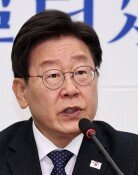Intel to invest 22 trillion won in foundry
Intel to invest 22 trillion won in foundry
Posted March. 25, 2021 07:36,
Updated March. 25, 2021 07:36
The world’s biggest semiconductor company Intel will build semiconductor plants in the U.S. to enter the commissioned semiconductor fabrication, also known as foundry, market. The company has also announced its plan to actively attract the clients of Taiwan’s TSMC and South Korea’s Samsung Electronics, which are ranked No. 1 and No. 2 in the foundry industry. Changes in the global supply chain triggered by a new cold war between the U.S. and China are beginning to affect the South Korean semiconductor industry.
Intel announced on Wednesday a plan to build two foundry plants in Arizona with 20 billion dollars. The company, which currently focuses on the design and production of CPUs of PCs and servers, will be commissioned by Amazon, Google, Microsoft, Qualcomm, and Apple to produce semiconductors. These are the major clients of Samsung Electronics and TSMC. “Semiconductor manufacturing facilities concentrated in Asia will be built in the U.S. and Europe,” CEO of Intel Pat Gelsinger said.
While the recent decision was prompted by reasons including its competitor AMD’s closing the gap, the decisive factor was the Biden administration’s policy. U.S. President Joe Biden issued an administrative order to examine the global supply chain in four key areas, including semiconductors, at the end of February and promised massive support for companies producing semiconductors in the U.S.
The European Union also recently announced a plan to produce 20 percent of global semiconductors manufactured globally by 2030. The plan is to reduce the region’s dependency on Asia by investing 134.5 billion euros or 180 trillion won to double the regional production of semiconductors. The diplomacy and security strategies of the U.S. and Europe to exclude China from the supply chain of key parts and materials are likely to have a negative impact on South Korean industries.
While South Korea’s Samsung Electronics and SK Hynix have world-class competitiveness in DRAM and NAND flash, they lag behind the U.S., Taiwan, and Japan in other areas, including custom semiconductors and semiconductor manufacturing facilities. For example, when there was a fire in a Japanese automotive semiconductor plant, officials of Hyundai Motor Group and the South Korean government had to demand more supply from Taiwan. The foundry market share of Samsung Electronics, which is ranked No. 2 worldwide, is only one-third of that of TSMC.
While governments worldwide are making active efforts to develop the semiconductor industry from the perspective of a future national strategy, South Korea is reliant on major companies’ individual skills for investment, technology development, and talent training. Failure to prepare for the walls of nationalism built by countries around the world while dreaming of a supercycle, in which the prices of semiconductors go up as consumption suppressed from COVID-19 explodes, will lead to a huge decline in South Korea’s export in just a few years.







